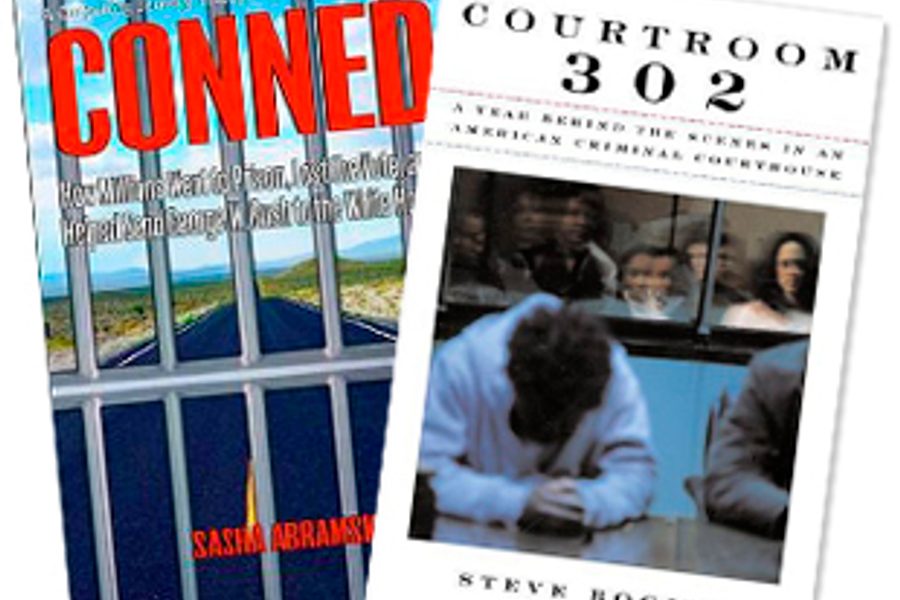Reporting on Americas Most Unwanted
Immersion journalists Sasha Abramsky and Steve Bogira bring the lives of the impoverished, adjudicated and disenfranchised to life.
Silja J.A. Talvi

From the car seat of his 1998 Nissan Altima, journalist Sasha Abramsky views the American landscape through a multifocal lens. So too does journalist Steve Bogira, from the purview of an uncomfortable courtroom bench. But wherever they are, each spends his time documenting the nation’s most unwanted citizens: the impoverished, adjudicated, imprisoned, and disenfranchised.
Neither Abramsky nor Bogira come across as pessimists. Both recognize the myriad ways in which individuals and communities strive for the American dream. But as journalists, both also focus their attention on the sociopolitical inequalities that thwart those democratic aspirations – inequalities woven so deeply into the national fabric that they seem impossible to extract.
Abramsky and Bogira are both part of a small but influential set of “immersion” journalists who identify those systems of inequality and the legislative or social trends that reinforce them. Such reporters not only celebrate the grand American tradition of muckraking journalism, but intentionally defy the dominant reporting mode of bland and ostensibly “objective” newspaper reportage that asserts each point of view as equal.
They also stand in opposition to alarmist, reactionary punditry passed off as news. This conservative cabal of media conglomerates (and their offensively brash talking heads) dominate the American airwaves. In stark contrast, immersion journalists like Abramsky and Bogira offer audiences an analytical and literary antidote.
Robert S. Boynton, director of New York University’s graduate magazine journalism program, includes immersion reportage in his recent book The New New Journalism.
“[T]his new generation experiments more with the way one gets the story,” he writes. “To that end, they’ve developed innovative immersion strategies … and extended the time they’ve spent reporting.” They don’t just follow a single lead, he explains, they follow several down paths that lead to unexpected, often jarring and illuminating places.
On the road with Abramsky
Abramsky’s ability to hone in on undercovered, emerging social trends has been apparent since he burst onto the American journalism scene. His first major exposé on the American prison system was published in The Atlantic Monthly when British-born Abramsky was just 26. For that piece, he and noted photographer Andrew Lichtenstein waded into a world that few outsiders wanted to experience: sprawling prison yards, maximum-security lock-ups and privately-run companies behind prison walls – a system of mass incarceration that, as Abramsky correctly surmised, was in the process of becoming a full-fledged “prison industrial complex.”
Abramsky’s initial experiences with American prisons only intensified his desire to dive deeper. Since writing the exposé Abramsky, now 34, relocated from New York City to Sacramento, California, and has traveled extensively through most states in the union – no less than 13 of them for his newest book, Conned: How Millions Went to Prison, Lost the Vote, and Helped Send George W. Bush to the White House (The New Press, 2006).
Abramsky had already figured out how to use a combination of instinct and carefully-honed contacts to motor toward a good story. In Conned, Abramsky does so again, cruising down the Delta’s blues-song-inspiring Highway 61, or through the prophetic-vision-prompting mountain ranges leading into the far more sullen, Mormon-controlled State of Utah.
Wherever he went, Abramsky had no problem finding pockets of abject poverty, clusters of trailer homes, gaudy billboards for casinos (and the even-gaudier casinos), and ample evidence of communities struggling to stay alive despite the economic odds.
His bigger challenge: to locate some of the millions of disenfranchised American ex-offenders who could articulate their opinions about being deprived of the right to vote, whether temporarily – or, as is often the case, for the rest of their lives. Many former prisoners were suspicious of his questions; others had already headed back into lives of criminality and wanted to stay there, undisturbed by a reporter’s inquiries.
Abramsky realized that as a British-accented, intellectual-looking white man, he couldn’t easily journey into a predominantly African American Southern town and get unemployed ex-offenders standing on street corners to talk about their lives. Instead, Abramsky used the time-honored method of cultivating networks, seeking out formal and informal introductions to gain invitations into the kitchens, bars, and meeting places where such conversations could openly take place.
Abramsky had to be willing to check in on his own biases as he progressed in his research, eventually confronting his own preconceptions of the disenfranchised masses as largely disinterested in their own voting rights and lack of political power.
“As I went around the country I began to realize how important the issue was for [the disenfranchised themselves], far beyond the realm of the theoretical,” he explains. “One after another, they talked about how depressed, how angry, how disempowered they felt about not being able to vote, to be able to affect their [national and local politics], choose people for their school boards, and so on … We can never judge individual people behind these macro stereotypes of what [former prisoners] are like.”
Although felony disenfranchisement laws have been on the books in many American states since their inception, neither the press nor the politicians had paid them much heed until George W. Bush first rode to victory in 2000. His vehicle was less a legitimate chariot than a modern-day bandit’s buggy intent on robbing as many people of the right to vote as possible, but Bush became president all the same.
Ample evidence came to light, post-election, to indicate the degree to which the polls had been purged, quite illegally and not-so-accidentally, after all. At the top of the list was the state of Florida, which hired “partisan companies to ‘scrub’ the electoral rolls of possible felons,” as Abramsky writes in Conned.
In the period since Bush’s election and re-election, some states have moved toward genuine reform of their disenfranchisement and re-enfranchisement laws. But most of those voting procedures and systems of disenfranchisement have remained status quo.
From Abramsky’s and Bogira’s point of view, the “justice” system has little vested interested in seeing any real rehabilitation or reintegration of ex-offenders. Designed to retain pockets of immense wealth and political power, the system instead has an interest in ensuring that the 5 million disenfranchised Americans remain powerless in their country’s own electoral system.
In Montana, for instance, Abramsky finds a drug treatment center and meets 21-year-old Chereesa, a Cheyenne-Navajo woman, who had been hit with a federal conviction for interstate transportation of marijuana. That Chereesa was merely 18-years-old, pled guilty and did her time didn’t matter; she was told by her probation officer that she had lost her right to vote. “I wanted to vote,” Chereesa tells Abramsky. “I’m a public kind of person … [not being able to vote] made me feel … like I was bad, like I was not a citizen anymore.
Actually, Montana’s laws would have allowed her to regain the right to vote. But miscommunication – or intentional disregard for the law – allowed for this common miscarriage of justice within the framework of its own “justice” system.
Behind the scenes with Bogira
Steve Bogira has a vision of what the criminal justice system could truly accomplish if it actually fulfilled its role as a protector of American rights of due process; as a guardian of the right to a jury trial by one’s own peers; and as a guard against the specter of cruel and unusual punishment. But after immersing himself in Chicago’s Cook County Correctional Facility in 1998 (and then re-interviewing subjects over the course of several years) Bogira knows that those hopes are very far from being realized.
“The system is a landfill,” says Bogira, 51, the author of Courtroom 302: A Year Behind the Scenes in an American Criminal Courthouse (Random House, Paperback 2006). Based in Chicago, Bogira centered his work on the busiest and largest felony courthouse in the U.S.: Roughly 9,000 inmates are held at any given time, many of them indigent and unable to post bail as they await hearings.
In Courtroom 302, Judge Dan Locallo presides over dozens of cases per day, and it is here that the keenly perceptive Bogira sets up a ground-level observation post, monitoring the people who make the court system tick: attorneys, guards, deputies, juries, and other court personnel. Bogira soon found that most employees were more than willing to share their experiences, taking their cue from Judge Locallo’s own willingness to open his courtroom to the intrepid reporter.
“It’s amazing what you can accomplish as a reporter when you just listen to someone,” says Bogira. “There are two, related things about our job that I love most: being a busybody because you have an excuse to ask people questions; and the feeling that you’re honoring the other person, and that’s a good feeling. Take the court clerks and jail guards, for instance. Usually nobody ever comes and talks to them. It’s clear we’re not really interested. When they see that someone is really interested, they feel like they’re being recognized, even honored, for the work they do.”
Down in the dungeons of the facility, Bogira witnesses and relates the book’s rawest, most gut-wrenching experiences, where guards wage a daily low-level war against detainees, many of whom are suffering from HIV, chronic drug addiction, and/or serious mental illnesses. Bogira recounts many of those experiences in chilling detail, including the sights and sounds of detainees withdrawing from crack or heroin; the barked commands, derogatory and racist comments, and even the violent tempers of guards who quickly lose patience with their charges.
“It’s where people who have become the refuse of our society are processed, buried,” he says frankly.
Bogira’s approach toward the courthouse and the jail system differ from that of many other criminal justice-focused journalists in that he does not focus on the miscarriages of justice so much as the “predictable outcomes of urban poverty.”
“We journalists tend to focus too much on aberrations,” Bogira explains. “We love the story of innocent people who are convicted and we love it if we can help free them. But to me as a journalist, it’s a dead end, in a way. You can’t get at what’s causing crime by writing about the truly innocent.”
Different trenches, similar goals
There are other notable similarities between Abramsky’s and Bogira’s projects. In tackling book-length immersion journalism, both writers go to great lengths to learn what it takes to gain the trust of their subjects. Both are willing to admit to failures in the process of their reporting: the days where leads go nowhere, the moments where long waits or drives yield nothing. Some days, neither could hold the interest of a subject or realized that their subjects were more interested in personal gain – the (misperception) that they might get paid for their story, for instance – than in contributing to a deeper understanding of the issues at hand.
The biggest difference between these works of non-fiction lies in the physical environments the writers encounter. Bogira’s Courtroom 302, by intent and necessity, keeps him largely confined within walls, long underground corridors, jail cells, and stiff courtroom benches. For his part, Abramsky plumbs the physical context of the American landscape that continues to both capture and churn the literary imagination.
Whether driving down the wide expanse of American highways, or sorting through hundreds of courtroom case files, both Abramsky and Bogira are infinitely more comfortable seeing themselves as “immersion” and “muckraking” journalists than being labelled “advocacy” journalists. This term, Abramsky cautions, generates the “risk that you’ll be seen as a propagandist.”
“I make it very clear in [Conned] that these disenfranchisement laws have no place in modern day society,” he explains, “but my prime goal is to tell the [stories of these ex-offenders] as compellingly as possible … and bringing [voice] to people whose very lives have been defined by other people telling them they’re not important.”
Instead of lecturing to readers, or trying to impress them with shocking stories of travesty or triumph, Bogira encourages journalists who write about criminal justice to invest more day-to-day time in the lives of the people who really have committed the crimes of which they’ve been accused. To do so, he says, reporters should try immersing themselves to the degree that they begin to understand why people “do what they do.”
“This justice system is not at all interested in what the causes of crime are,” adds Bogira. “But we should be.”







